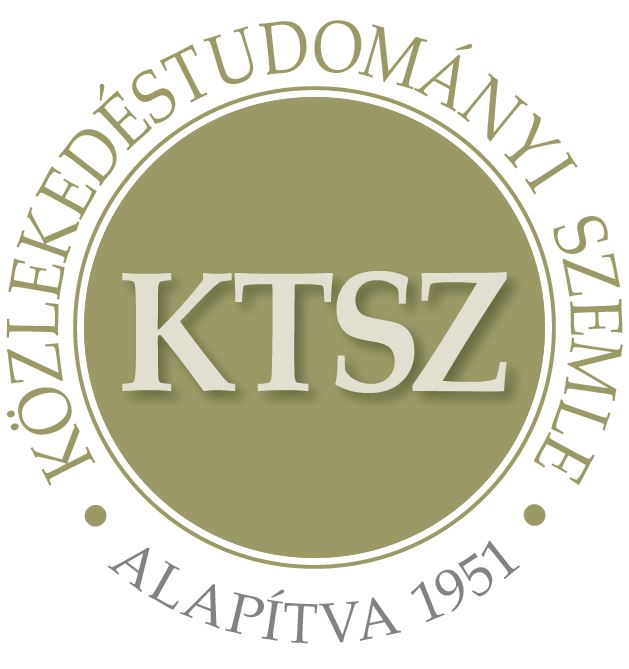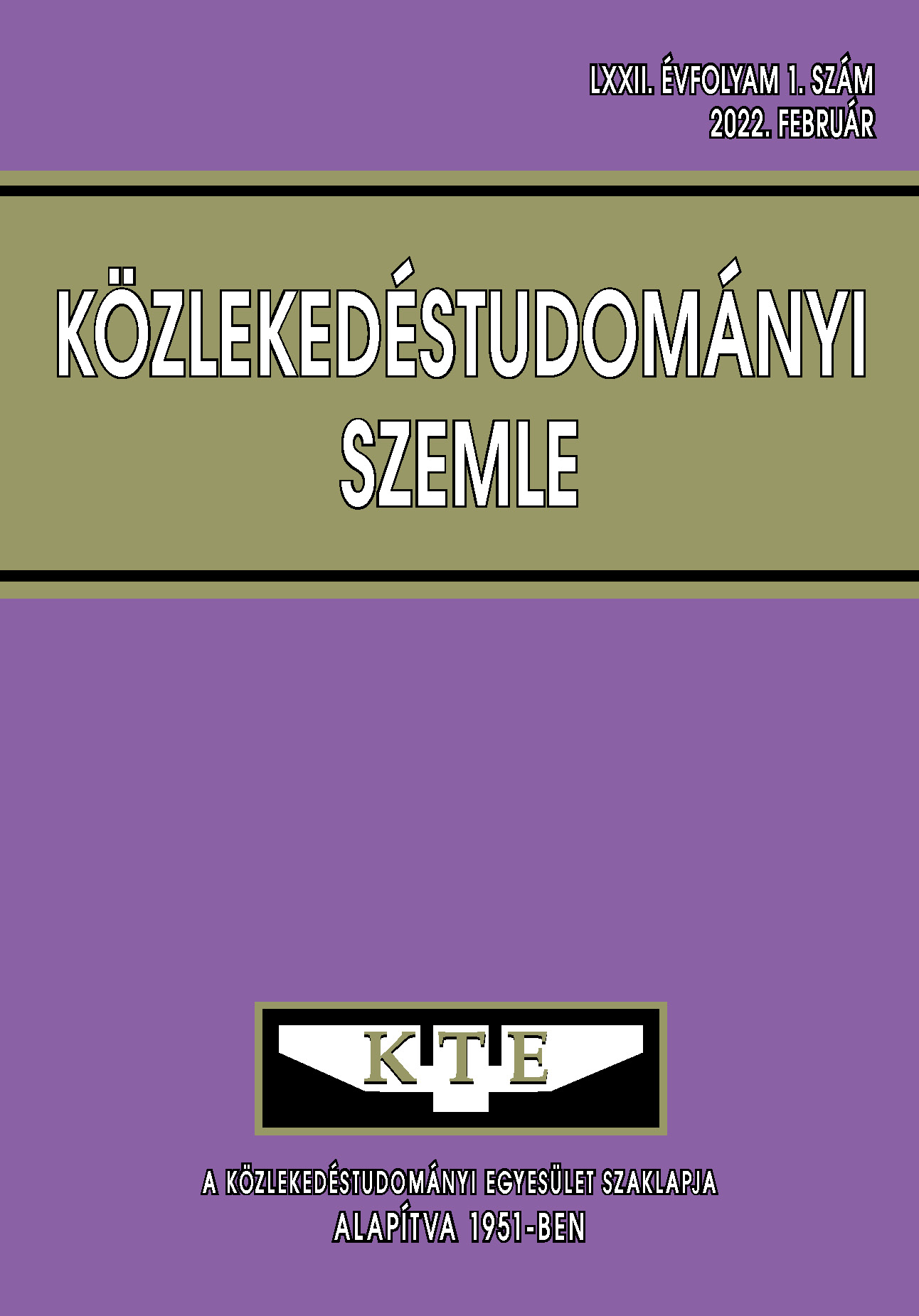Estimation of the ‘from where to where’ traffic of roundabouts using state space theory methods
Abstract
This paper describes the different traffic counting methods, the estimation methods used during the development, and the international research and examples of estimating the turnaround rates. Based on real traffic counts, the different statespace theory estimation methods are calibrated and their accuracy is compared using performance indicators. Finally, an
examination of the accuracy of the most efficient estimation method is presented in different traffic situations in a validated simulation environment.
References
C. Taylor; R. Kennedy; Y. Yang, Commission, D.V. R. P. Commission, et al., Automated video-based traffic count analysis, University of Pennsylvania, 2016
I. Budinska, On ethical and legal issues of using drones, In Aspragathos, International Conference on Robotics in Alpe-Adria Danube Region, Springer International Publishing, Cham, 2018
T. Luspay; T. Tettamanti; I. Varga, Forgalomirányítás: közúti járműforgalom modellezése és irányítása, Typotex, 2011, ISBN 978-963-279-665-9
M. Dixon; L. Rilett, Population origin–destination estimation using automatic vehicle identification and volume data, Journal of Transportation Engineering, 2005 DOI: https://doi.org/fcp943
M. Dixon; A. Abdel-Rahim; M. Kyte; P. Rust; H. Cooley; L. Rodegerdts, Field evaluation of roundabout turning movement estimation procedures, Journal of Transportation Engineering, 2007 DOI: https://doi.org/df4srk
E. Papapanagiotou; J. Kaths; F. Busch, Kalman filter for turning rate estimation at signalized intersections, based on floating car data, Transportation Research Procedia, TUM 2018 DOI: https://doi.org/hb46
B. Kulcsár; T. Bécsi; I. Varga, Estimation of dynamic origin destination matrix of traffic systems, Periodica Polytechnica Transportation Engineering, 2005
R. E. Kalman, A new approach to linear filtering and prediction, Journal of Basic Engineering (ASME), 1960, 35-45
T. Tettamanti; I. Varga; A. Csikós, Közúti mérések, eszközök és módszerek a közúti járműforgalom megfigyelésére. Typotex Kiadó, Budapest, 2016, ISBN 978-963-279-916-2
T. Tettamanti; T. Luspay; I. Varga, Road Traffic Modeling and Simulation, Akadémiai Kiadó, 2019, https://mersz.hu/tettamantiluspay-varga-road-traffic-modeling-andsimulation
N. Gupta; R. Hauser, Kalman filtering with equality and inequality state constraints, arXiv preprint arXiv:0709.2791, 2007
D. Simon, Kalman filtering with state constraints: a survey of linear and nonlinear algorithms, IET Control Theory & Applications, 2010, 4(8):1303–1318
M. Lay, Handbook of Road Technology, SponPress, Abingdon, UK, 2009
Magyar Közút Nonprofit Zártkörűen Működő Részvénytársaság, Országos közutak keresztmetszeti forgalomszámlálása és a forgalom nagyságának meghatározása, Útügyi Műszaki Előírás, 2009
C. Chen; J. Twycross; J. M. Garibaldi, A new accuracy measure based on bounded relative error for time series forecasting, PloS one, 2017, 12(3):e0174202 DOI: https://doi.org/f9v4kd
Zs. Bede; A. Csikós; M. T. Horváth; T. Tettamanti; I. Varga, Közúti forgalommodellezési gyakorlatok, Budapesti Műszaki és Gazdaságtudományi Egyetem, 2018
M. Takács, Forgalomszimulációs elemzések egységes vizsgálati módszertanának kidolgozása, 2004
O. Feldman, The GEH measure and quality of the highway assignment models, Association for European Transport and Contributors, 2012, 1–18
TfL (Transport for London), Traffic Modelling Guidelines: TfL Traffic Manager and Network Performance Best Practice Version 3.0, 2010
Articles published electronically are open access (OJS), freely available online and can be downloaded. Authors of articles are not charged any publication or publishing costs (APC). Users have the right to read, download, copy, print, and search the articles, or share the full text with a link.
Authors must declare that their submission has not been previously published in another journal, that financial support has been acknowledged, and that the list of references is complete and accurate, including specification of URLs and DOIs (if available). When submitting a draft article, each author approves the submitted version. Authors guarantee that the article is their original work. Authors are required to participate in the peer review process, follow the advice of reviewers, meet the prescribed deadlines, and, if any, withdraw the submission or correct errors.
All submitted articles are subject to peer review, where the editors request an independent evaluation from at least one expert, ensuring that the reviewer(s) have no conflicts of interest with the authors. The final decision is made by the Editor-in-Chief, who takes into account the evaluations and the suggestions of the editors. The editors and reviewers treat the submission confidentially.
The publisher and editors are committed to maintaining high ethical standards and to preventing publications that involve research misconduct. They follow the COPE guidelines on such ethical issues.
The authors retain copyright and grant the journal the right of first publication under the Creative Commons License (https://creativecommons.org/licenses/by-nc-nd/4.0), which allows others to share the work, while acknowledging the authorship of the work and the first publication in the journal.
The journal archives all published articles, and the journal's owner, the Hungarian Society of Transportation Sciences, will continue to operate the database even if the journal ceases to be published.















